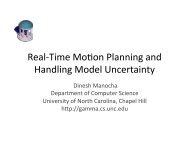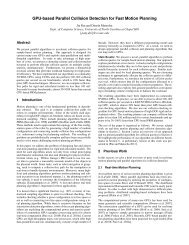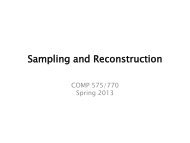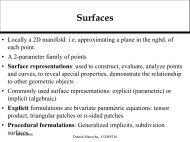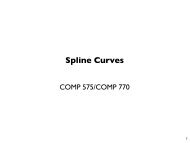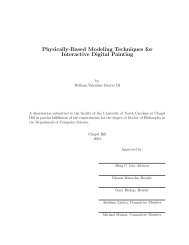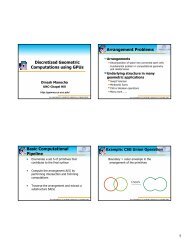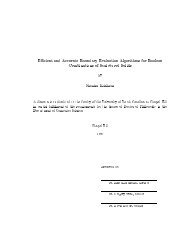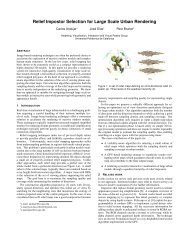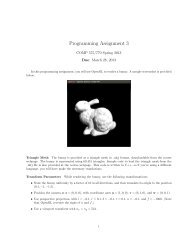Adaptive Frustum Tracing for Interactive Sound Propagation
Adaptive Frustum Tracing for Interactive Sound Propagation
Adaptive Frustum Tracing for Interactive Sound Propagation
Create successful ePaper yourself
Turn your PDF publications into a flip-book with our unique Google optimized e-Paper software.
c○2009 IEEE. Reprinted, with permission, from IEEE TRANSACTION ON VISUALIZATION AND COMPUTER GRAPHICS, VOL. 14, NO. 6, NOVEMBER/DECEMBER 2008<br />
amplitude<br />
Adaptve Volume <strong>Tracing</strong> (Source=S1, Listener=L1, Subdivision=2)<br />
0.9<br />
0.8<br />
0.7<br />
0.6<br />
0.5<br />
0.4<br />
0.3<br />
0.2<br />
0.1<br />
0<br />
0 2000 4000 6000 8000 10000<br />
time<br />
(c) 23 contributions<br />
(a) Theater benchmark<br />
amplitude<br />
Adaptve Volume <strong>Tracing</strong> (Source=S1, Listener=L1, Subdivision=4)<br />
0.9<br />
0.8<br />
0.7<br />
0.6<br />
0.5<br />
0.4<br />
0.3<br />
0.2<br />
0.1<br />
0<br />
0 2000 4000 6000 8000 10000<br />
time<br />
(d) 33 contributions<br />
amplitude<br />
0.9<br />
0.8<br />
0.7<br />
0.6<br />
0.5<br />
0.4<br />
0.3<br />
0.2<br />
0.1<br />
Image Source (Source=S1, Listener=L1)<br />
0<br />
0 2000 4000 6000 8000 10000<br />
time<br />
(b) 65 contributions<br />
amplitude<br />
Adaptve Volume <strong>Tracing</strong> (Source=S1, Listener=L1, Subdivision=5)<br />
0.9<br />
0.8<br />
0.7<br />
0.6<br />
0.5<br />
0.4<br />
0.3<br />
0.2<br />
0.1<br />
0<br />
0 2000 4000 6000 8000 10000<br />
time<br />
(e) 60 contributions<br />
Fig. 9. (a) Theater benchmark with 54 triangles. (b) Impulse response<br />
generated by image source method <strong>for</strong> 3 reflections. (c)–(e) Impulse<br />
responses generated by our approach with maximum sub-division depth<br />
of 2, 4, and 5 respectively <strong>for</strong> 3 reflections.<br />
level of dynamism in the scene, and the relative placement of objects<br />
with respect to the sources and receiver. As part of a pre-process, we<br />
compute a bounding volume hierarchy of AABBs. This hierarchy is<br />
updated as some objects in the scene move or some objects are added<br />
or deleted from the scene. Our current implementation uses a linear<br />
time refitting algorithm that updates the BVH in a bottom-up manner.<br />
If there are topological changes in the scene (e.g. explosions), than the<br />
resulting hierarchy can have poor culling efficiency and can result in<br />
more intersection tests [39]. The complexity of each frustum intersection<br />
test is almost logarithmic in the number of scene primitives and<br />
linear in the number of sub-frusta generated based on adaptive subdivision.<br />
The actual number of frusta traced also vary as a function of<br />
number of reflections as well as the relative orientation of the objects.<br />
7.1 Comparison<br />
The notion of using an adaptive technique <strong>for</strong> geometric sound propagation<br />
is not novel. There is extensive literature on per<strong>for</strong>ming adaptive<br />
supersampling <strong>for</strong> path or ray tracing in both sound and visual<br />
rendering. However, the recent work in interactive ray tracing <strong>for</strong> visual<br />
rendering has shown that adaptive sampling, despite its natural<br />
advantages, does not per<strong>for</strong>m near as fast as simpler approaches that<br />
are based on ray-coherence [39]. On the other hand, we are able to<br />
per<strong>for</strong>m fast intersection tests on the AD-Frusta using ray-coherence<br />
and the Plücker coordinate representation. By limiting our <strong>for</strong>mulation<br />
to 4-sided frusta, we are also able to exploit the SIMD capabilities of<br />
current commodity processors.<br />
Many adaptive volumetric techniques have also been proposed <strong>for</strong><br />
geometric sound propagation. Shinya et al. [1987] traces a pencil<br />
of rays and require that the scene has smooth surfaces and no edges,<br />
which is infeasible as most models of interest would have sharp edges.<br />
Rajkumar et al. [1996] used static BSP tree structure and the beam<br />
starts out with just one sample ray and is subdivided only at primitive<br />
intersection events. This can result into sampling problems due to<br />
missed scene hierarchy nodes. Drumm and Lam [2000] describe an<br />
adaptive beam tracing algorithm, but it is not clear whether it can handle<br />
complex, dynamic scenes. The volume tracing <strong>for</strong>mulation [12]<br />
shoots pyramidal volume and subdivides them in case they intersect<br />
with some object partially. This approach has been limited to visual<br />
rendering and there may be issues in combining this approach with a<br />
scene hierarchy. The benefits over the ray-frustum approach [19, 18]<br />
are shown in Fig. 5. The propagation based on AD-<strong>Frustum</strong> traces<br />
fewer frusta.<br />
In many ways, our adaptive volumetric tracing offers contrasting<br />
features as compared to ray tracing and beam tracing algorithms. Ray<br />
tracing algorithms can handle complex, dynamic scenes and can model<br />
diffuse reflections and refraction on top of specular reflection and<br />
diffraction. However, these algorithms need to per<strong>for</strong>m very high su-<br />
amplitude<br />
Adaptve Volume <strong>Tracing</strong> (Source=S1, Listener=L1, Subdivision=2)<br />
1.4<br />
1.2<br />
1<br />
0.8<br />
0.6<br />
0.4<br />
0.2<br />
0<br />
0 2000 4000 6000 8000 10000<br />
time<br />
(c) 23 contributions<br />
(a) Factory benchmark<br />
amplitude<br />
Adaptve Volume <strong>Tracing</strong> (Source=S1, Listener=L1, Subdivision=4)<br />
1.4<br />
1.2<br />
1<br />
0.8<br />
0.6<br />
0.4<br />
0.2<br />
0<br />
0 2000 4000 6000 8000 10000<br />
time<br />
(d) 32 contributions<br />
amplitude<br />
1.4<br />
1.2<br />
1<br />
0.8<br />
0.6<br />
0.4<br />
0.2<br />
Image Source (Source=S1, Listener=L1)<br />
0<br />
0 2000 4000 6000 8000 10000<br />
time<br />
(b) 40 contributions<br />
amplitude<br />
Adaptve Volume <strong>Tracing</strong> (Source=S1, Listener=L1, Subdivision=5)<br />
1.4<br />
1.2<br />
1<br />
0.8<br />
0.6<br />
0.4<br />
0.2<br />
0<br />
0 2000 4000 6000 8000 10000<br />
time<br />
(e) 41 contributions<br />
Fig. 10. (a) Factory benchmark with 174 triangles. (b) Impulse response<br />
generated by image source method <strong>for</strong> 3 reflections. (c)–(e) Impulse<br />
responses generated by our approach with maximum sub-division depth<br />
of 2, 4, and 5 respectively <strong>for</strong> 3 reflections.<br />
persampling to overcome noise and aliasing problems, both spatially<br />
and temporally. For the same accuracy, propagation based on AD-<br />
<strong>Frustum</strong> can be much faster than ray tracing <strong>for</strong> specular reflections<br />
and edge diffraction.<br />
The beam tracing based propagation algorithms are more accurate<br />
as compared to our approach. Recent improvements in the per<strong>for</strong>mance<br />
of beam tracing algorithms [24, 17] are promising and can<br />
make them applicable to more complex static scenes with few tens<br />
of thousands of triangles. However, the underlying complexity of per<strong>for</strong>ming<br />
exact clipping operations makes beam tracing more expensive<br />
and complicated. In contract, AD-<strong>Frustum</strong> compromises on the<br />
accuracy by per<strong>for</strong>ming discrete clipping with the 4-sided frustum.<br />
Similarly, image-source methods are rather slow <strong>for</strong> interactive applications.<br />
7.2 Limitations<br />
Our approach has many limitations. We have already addressed the<br />
accuracy issue above. Our <strong>for</strong>mulation cannot directly handle diffuse,<br />
lambertian or “glossy” reflections. Moreover, it is limited to<br />
point sources though we can potentially simulate area and volumetric<br />
sources if they can be approximated with planar surfaces. Many of the<br />
underlying computations such as maximum-subdivision depth parameter<br />
and intersection test based on Plücker coordinate representation<br />
are conservative. As a result, we may generate unnecessary sub-frusta<br />
<strong>for</strong> tracing. Moreover, the shape of the diffraction frustum may extend<br />
beyond the actual diffraction field originating from the edge. Limitations<br />
of UTD-based edge diffraction are mentioned in Section 4.1.<br />
Currently, our audio rendering system does not per<strong>for</strong>m interpolation<br />
of parameters, as suggested in [42, 35], and hence could result in some<br />
clicking artifacts when per<strong>for</strong>ming interactive audio rendering.<br />
8 CONCLUSION AND FUTURE WORK<br />
We present an adaptive volumetric tracing <strong>for</strong> interactive sound propagation<br />
based on transmissions, specular reflections and edge diffraction<br />
in complex scenes. Our approach uses a simple, adaptive frustum<br />
representation that provides a balance between accuracy and interactivity.<br />
We verify the accuracy of our approach by comparing the per<strong>for</strong>mance<br />
on simple benchmarks with commercial state-of-the-art software.<br />
Our approach can handle complex, dynamic benchmarks with<br />
tens or hundreds of thousands of triangles. The initial results seem



